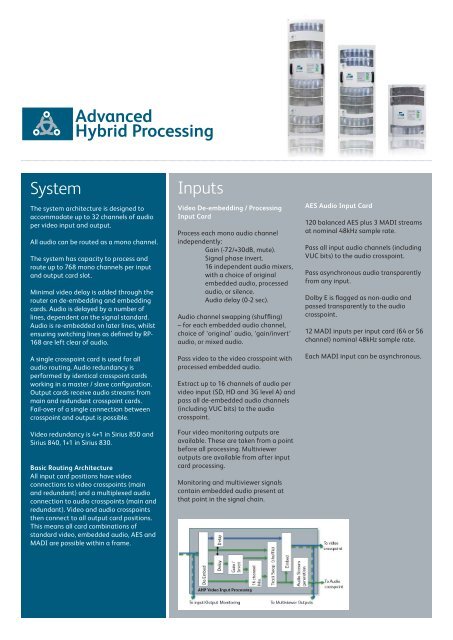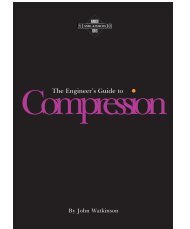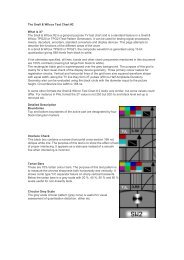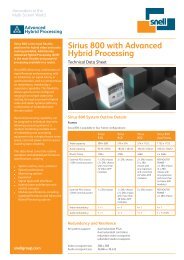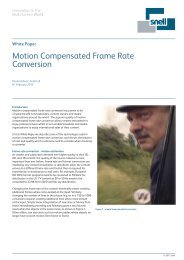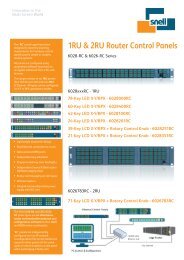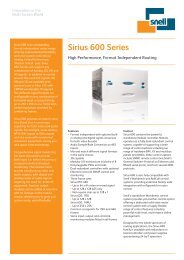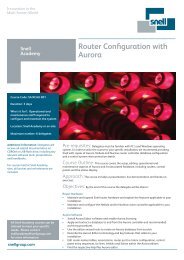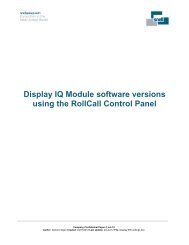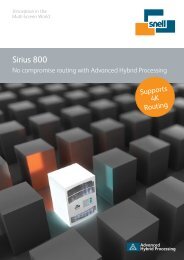Sirius 800 - Snell
Sirius 800 - Snell
Sirius 800 - Snell
Create successful ePaper yourself
Turn your PDF publications into a flip-book with our unique Google optimized e-Paper software.
System<br />
The system architecture is designed to<br />
accommodate up to 32 channels of audio<br />
per video input and output.<br />
All audio can be routed as a mono channel.<br />
The system has capacity to process and<br />
route up to 768 mono channels per input<br />
and output card slot.<br />
Minimal video delay is added through the<br />
router on de-embedding and embedding<br />
cards. Audio is delayed by a number of<br />
lines, dependent on the signal standard.<br />
Audio is re-embedded on later lines, whilst<br />
ensuring switching lines as defined by RP-<br />
168 are left clear of audio.<br />
A single crosspoint card is used for all<br />
audio routing. Audio redundancy is<br />
performed by identical crosspoint cards<br />
working in a master / slave configuration.<br />
Output cards receive audio streams from<br />
main and redundant crosspoint cards.<br />
Fail-over of a single connection between<br />
crosspoint and output is possible.<br />
Video redundancy is 4+1 in <strong>Sirius</strong> 850 and<br />
<strong>Sirius</strong> 840, 1+1 in <strong>Sirius</strong> 830.<br />
Basic Routing Architecture<br />
All input card positions have video<br />
connections to video crosspoints (main<br />
and redundant) and a multiplexed audio<br />
connection to audio crosspoints (main and<br />
redundant). Video and audio crosspoints<br />
then connect to all output card positions.<br />
This means all card combinations of<br />
standard video, embedded audio, AES and<br />
MADI are possible within a frame.<br />
Inputs<br />
Video De-embedding / Processing<br />
Input Card<br />
Process each mono audio channel<br />
independently:<br />
Gain (-72/+30dB, mute).<br />
Signal phase invert.<br />
16 independent audio mixers,<br />
with a choice of original<br />
embedded audio, processed<br />
audio, or silence.<br />
Audio delay (0-2 sec).<br />
Audio channel swapping (shuffling)<br />
– for each embedded audio channel,<br />
choice of ‘original’ audio, ‘gain/invert’<br />
audio, or mixed audio.<br />
Pass video to the video crosspoint with<br />
processed embedded audio.<br />
Extract up to 16 channels of audio per<br />
video input (SD, HD and 3G level A) and<br />
pass all de-embedded audio channels<br />
(including VUC bits) to the audio<br />
crosspoint.<br />
Four video monitoring outputs are<br />
available. These are taken from a point<br />
before all processing. Multiviewer<br />
outputs are available from after input<br />
card processing.<br />
Monitoring and multiviewer signals<br />
contain embedded audio present at<br />
that point in the signal chain.<br />
AES Audio Input Card<br />
120 balanced AES plus 3 MADI streams<br />
at nominal 48kHz sample rate.<br />
Pass all input audio channels (including<br />
VUC bits) to the audio crosspoint.<br />
Pass asynchronous audio transparently<br />
from any input.<br />
Dolby E is flagged as non-audio and<br />
passed transparently to the audio<br />
crosspoint.<br />
12 MADI inputs per input card (64 or 56<br />
channel) nominal 48kHz sample rate.<br />
Each MADI input can be asynchronous.


